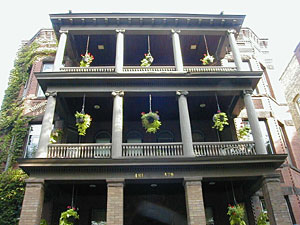|
Audio
Photos
Your Voice
|
F. Scott Fitzgerald's home becomes a landmark
September 24, 2004
 |
| The Fitzgerald's lived at 481 Laurel Avenue for about two years until Scott's father lost his job as a wicker furniture salesman. (MPR Photo/Greta Cunningham) |
St. Paul, Minn. — The birthplace of one of American's greatest novelists is in the middle of a tree-lined street in St. Paul's Ramsey Hill neighborhood. The actual birthplace is a second floor apartment in a building originally named the San Mateo Flats. As was the practice in 1896, Fitzgerald was born at home. He was named for his famous distant cousin on his father's side: Francis Scott Key, who course composed The Star Spangled Banner. The Fitzgerald's lived at 481 Laurel Avenue for about two years until Scott's father lost his job as a wicker furniture salesman. He moved the family to New York and then in 1908 the family moved back to St. Paul. This time they lived in a rented house on Summit Avenue.
In his writings, Fitzgerald liked to portray himself as a poor boy growing up among the rich. But David Page, one of the organizers who helped to get the National Literary Landmark designation for the apartment, says Fitzgerald's claim of poverty is a bit of artistic license.
 | |||
"The San Mateo Flats as they were called when they were built were considered upscale luxury apartments. He was not a poor boy. He may have been relatively less rich than the people he ran around with, but these were considered very nice apartments. He had a pretty comfortable life," according to Page.
David Page initially became interested in Fitzgerald after reading one of his novels in the 9th grade. He's written a new guidebook book about Fitzgerald's life in St. Paul. Page had a chance meeting with the current occupant of Fitzgerald's birthplace, retired University of Minnesota professor Richard McDermott.
"I remember meeting Richard at a party and going up to him and saying, 'can I come and look at your house?' And he was very gracious," said Page.
Richard McDermott is used to such requests. He has been living in F. Scott Fitzgerald's birthplace for nearly 30 years and has hosted Fitzgerald fans from all over the world, including one young woman from Mongolia. He first came to know about the apartment through an ad in the newspaper from an organization called Old Town Restorations.
McDermott and 12 of what he calls "urban pioneers" joined together with Old Town Restorations to reclaim the decaying building.
 | |||
McDermott says many of the houses in Ramsey Hill were drug-infested and the site of various other "colorful" crimes. He says the state of the Laurel Avenue building was horrible.
"Because they'd been chopped up into little small, share-the-bath, rabbit hutch apartments," he says. "And they were in really a severe state of detoriation. But Old Town Restorations, the folks there had the vision that they wanted to see if they could restore it. They knew of the historic significance of 481."
McDermott and the other "pioneers" spent their weekends tearing down old plaster, repairing ceilings and helping contractors restore the building.
"Knowing it was Fitzgerald's birthplace I tried to keep the old woodwork and the old high baseboards," says McDermott, who adds he made a nice discovery one day when he was taking down a wall.
"In front of you here you're looking at the fireplace and the fireplace wall. That was really quite a surprise to us. That was a bit of a mystery. The whole fireplace was never used. It was covered with plaster. So as we were knocking down plaster, lo and behold there was the fireplace."
 | |||
The Friends of the Library association chooses the sites that are selected as National Literary Landmarks. Other locations bearing National Literary Landmark plaques include the home of Tennessee Williams, the apartment where Margaret Mitchell wrote "Gone with the Wind" and the prairie made famous by Willa Cather in Red Cloud, Nebraska.
Fitzgerald historian David Page says the dedication of Fitzgerald's birthplace as a literary landmark is an important event for Minnesota.
"I think it's just another way that St. Paul can recognize the positive benefits that come from being associated with a writer like F. Scott Fitzgerald. He wrote a lot about St. Paul. And he considered it in some ways his hometown," Page said.
Richard McDermott says he's not afraid the new Literary Landmark Plaque on his building will draw more tourists because "it's a very positive feeling for me."
|
News Headlines
|
Related Subjects
|
